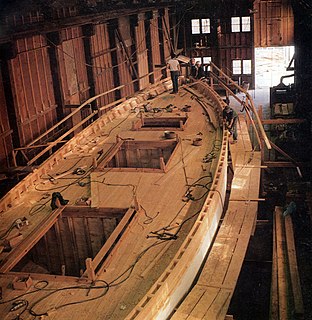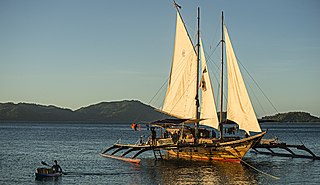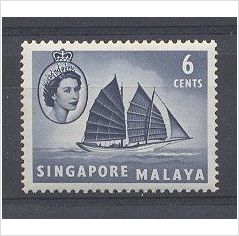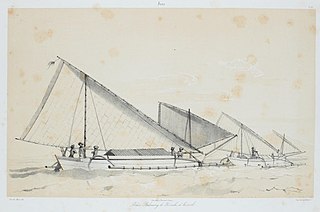
A yawl is a type of boat. The term has several meanings. It can apply to the rig, to the hull type or to the use which the vessel is put.

Boat building is the design and construction of boats and their systems. This includes at a minimum a hull, with propulsion, mechanical, navigation, safety and other systems as a craft requires.
This is a glossary of nautical terms; some remain current, while many date from the 17th to 19th centuries.

Proas are various types of multi-hull outrigger sailboats of the Austronesian peoples. The terms were used for native Austronesian ships in European records during the Colonial era indiscriminately, and thus can confusingly refer to the double-ended single-outrigger boats of Oceania, the double-outrigger boats of Island Southeast Asia, and sometimes ships with no outriggers or sails at all.

Timothy Severin was a British explorer, historian, and writer. Severin was noted for his work in retracing the legendary journeys of historical figures. Severin was awarded both the Gold Medal of the Royal Geographical Society and the Livingstone Medal of the Royal Scottish Geographical Society. He received the Thomas Cook Travel Book Award for his 1982 book The Sindbad Voyage.

The vinta is a traditional outrigger boat from the Philippine island of Mindanao. The boats are made by Sama-Bajau, Tausug and Yakan peoples living in the Sulu Archipelago, Zamboanga peninsula, and southern Mindanao. Vinta are characterized by their colorful rectangular lug sails (bukay) and bifurcated prows and sterns, which resemble the gaping mouth of a crocodile. Vinta are used as fishing vessels, cargo ships, and houseboats. Smaller undecorated versions of the vinta used for fishing are known as tondaan.

A kora-kora or kora kora or coracora is a traditional canoe from the Maluku (Moluccas) Islands, Indonesia. They are naval boat for carrying men on raids for plunder or for slaves. In Maritime Southeast Asia, raiding for slaves was an honourable way of making a living, and the kora kora was needed for defence against raids as well as for forays. Large kora-kora is called juanga or joanga.

Literally, the word pinisi refers to a type of rigging of Indonesian sailing vessels. A pinisi carries seven to eight sails on two masts, arranged like a gaff-ketch with what is called 'standing gaffs' - i.e., unlike most Western ships using such a rig, the two main sails are not opened by raising the spars they are attached to, but the sails are 'pulled out' like curtains along the gaffs which are fixed at around the centre of the masts.

Paraw are various double outrigger sail boats in the Philippines. It is a general term and thus can refer to a range of ship types, from small fishing canoes to large merchant lashed-lug plank boats with two outriggers (katig) propelled by sails

Balangay, also spelled barangay, is a type of lashed-lug boat built by joining planks edge-to-edge using pins, dowels, and fiber lashings. They are found throughout the Philippines and were used largely as trading ships up until the colonial era. The oldest known balangay are the Butuan boats, which have been carbon-dated to 320 AD and were recovered from several sites in Butuan, Agusan del Norte.

The Sparrow-Hawk was a 'small pinnace' similar to the full-rigged pinnace Virginia that sailed for the English Colonies in June 1626. She is the earliest ship to participate in the first decades of English settlement in the New World to have survived to the present day.

Naga Pelangi is a wooden junk rigged schooner of the Malay pinas type built using traditional lashed-lug techniques from 2004 to 2009 in Kuala Terengganu, Malaysia. Finished in 2010, it is operated as a charter vessel in South East Asia.

The pinas, sometimes called "pinis" as well, is one of two types of junk rigged schooners of the east coast of the Malay peninsula, built in the Terengganu area. This kind of vessel was built of Chengal wood by the Malays since the 19th century and roamed the South China Sea and adjacent oceans as one of the two types of traditional sailing vessels the late Malay maritime culture has developed: The bedar and the pinas.

The term bedar,, is applied to a wide variety of boats of the east coast of Malaysia that carry one or two junk sails and lack the typical transom stern of the perahu pinas. These junk rigged boats are usually built in the Terengganu area. The stern of the bedar is a classical "canu" or "pinky stern," being a typical "double ender", a bit like a modern ship's lifeboat, with a very full turn of the bilge and with markedly raked stem and stern. They came in small versions as small one-masted fishing vessels - anak bedar and were built as big as 90 feet over deck (LOD). The majority of the bedars were usually 45 to 60 feet over deck. The bedar, like all Terengganu boats, was built of Chengal wood by the Malays since the 19th century and roamed the South China Sea and adjacent oceans as a highly seaworthy traditional sailing vessel.

Perahu Mayang or simply mayang is a type of fishing boat from Java, Indonesia. This type of boat is used mainly for fishing and trading. Historically, this indigenous vessel is also favored by European skippers and private merchants for trading in East Indies: 50% of them were using mayang and pencalang. It is mostly used in northern coast of Java. The major production site is in Rembang, Central Java.

Janggolan refers to two different type of perahu from Indonesia. One is from Madura, and the other from Bali. The Madurese janggolan is a type of indigenously constructed boat, meanwhile Balinese janggolan is an indigenous boat with western-styled hull construction.

Paduwang is a traditional double-outrigger vessel from Madura, Indonesia. It is built with planks instead of single log, and used for fishing, trading and transport of people and goods near Madura island. In the 19th century, Paduwang was a popular fishing craft in East Java.

Orembai or Arombai is a type of plank boat from the Maluku Islands of Eastern Indonesia. It is mainly used for fishing and transport. This vessel is used as far as Batavia, where in the 17th century it became popular to go out "orembaaien" on an evening rowing on the river or city canals.

Lepa-lepa is a traditional canoe from the eastern part of the Indonesian archipelago. They are short range coastal fishing craft, but they can also be used for inter island voyages. The routes they took, among others are between Seram and Ambon-Lease, Geser island and Seram Laut, within Banda and Kei group of islands. They are already existed since at least 1500 A.D.

Lashed-lug boats are ancient boat-building techniques of the Austronesian peoples. It is characterized by the use of sewn holes and later dowels ("treenails") to stitch planks edge-to-edge onto a dugout keel and solid carved wood pieces that form the caps for the prow and stern. The planks are further lashed together and unto ribs with fiber ropes wrapped around protruding carved lugs on the inside surfaces. Unlike western boat-building techniques, the shell of the boat is created first, prior to being lashed unto ribs. The seams between planks are also sealed with absorbent tapa bark and fiber that expands when wet or caulked with resin-based preparations.

























